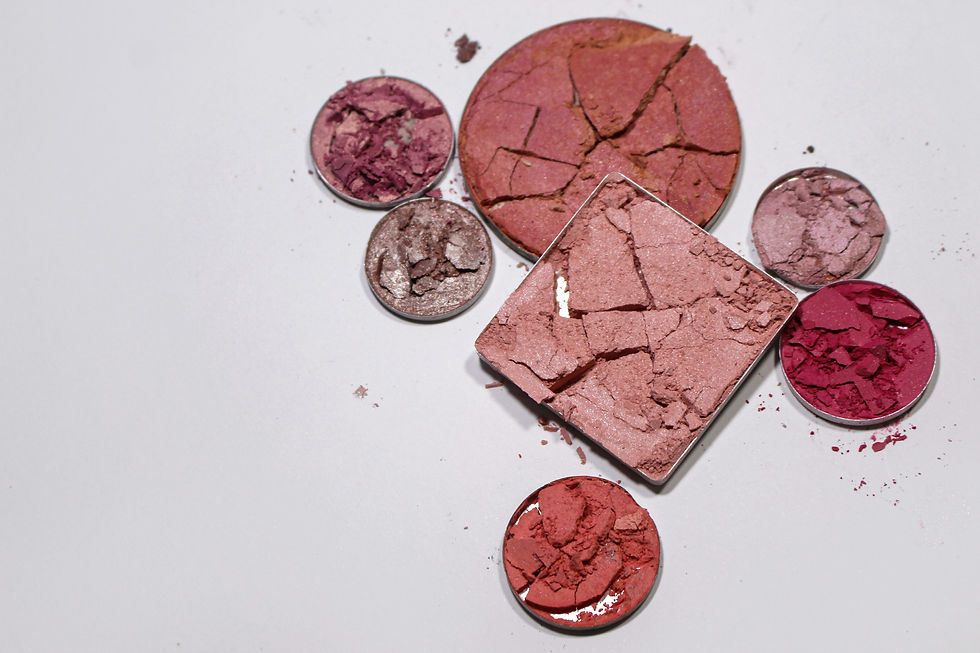The Making of Bismuth Oxychloride: What Really Happens
- The Joyfull Rose

- Oct 7
- 3 min read
Updated: 17 hours ago

In this post, learn how bismuth oxychloride is manufactured—what the production process looks like (per the article), where it comes from, and what purification steps are involved.
The Making of Bismuth Oxychloride: What Really Happens
Bismuth oxychloride (BiOCl) has become a controversial ingredient in some mineral makeup. While its pearlescent sheen can be visually appealing, its origins and the complexity of its manufacturing process are often less well known. Below is a breakdown of how bismuth oxychloride is typically produced, from raw material to finished cosmetic additive.
Sources of Bismuth
Natural occurrence: Bismuth is a naturally existing element, though it is not super abundant in a form that’s usable right away. It’s often found in ores together with other metals like lead, copper, and sometimes associated with impurities such as antimony, tellurium, or arsenic.
By‑product mining/refining: Much of the commercially used bismuth is obtained as a by‑product from refining other metals, especially lead and copper. As ores are processed, bismuth and some of its impurities are grouped among waste or side streams (for instance in anode slimes) in smelting operations.
Purification & Refinement Processes
Because raw bismuth (especially from mining or by‑product streams) typically contains undesirable impurities, a number of steps are used to purify it to cosmetic‑grade quality:
Initial smelting / collection from waste streams
As metals like lead or copper are smelted, some bismuth accumulates with other “smelter by‑products.” These materials (e.g. anode slimes) are rich in metal impurities.
Betts Process (Electrolytic refining step)
The Betts process is an electrolytic method used to separate bismuth from its accompanying impurities. In this step, bismuth is purified by running it in electrolytic solutions (which may include compounds like lead fluorosilicate and fluorosilicic acid) in order to strip away undesirable metals.
Zinc treatment and chlorination
After the Betts process, further impurity removal is performed, sometimes by using molten caustic zinc to chemically “scavenge” or displace impurities.
Once impurities are sufficiently reduced, chlorination is carried out to produce bismuth chloride. This is a more reactive form and an intermediate in the process.
Conversion to bismuth oxychloride
The bismuth chloride is then transformed (treated with water, etc.) to form a precipitate. After separating from water, it is further treated with dilute nitric acid solution of bismuth nitrate and sodium chloride.
The compound is then crystallized/evaporated to remove excess moisture and form the final bismuth oxychloride product. This final compound is what’s used in cosmetics for its pearlescent, shimmering qualities and adhesion properties.
Why It’s Not Exactly “Natural” Straight from the Ground
From the above, there are several steps indicating that bismuth oxychloride is not a raw earth‑mined mineral used directly:
The natural ore must undergo multiple purification steps (Betts process, zinc treatment, chlorination, etc.), which involve chemical reagents and processing.
Raw bismuth in natural form often includes heavy metal impurities (lead, arsenic, antimony), which can be problematic or toxic if not removed.
The final bismuth oxychloride compound is a chemically manipulated product, not simply ground‑up mineral. The precipitation, crystallization, acid treatments, etc., are all part of converting pre‑refined bismuth into a material that meets cosmetic safety standards.
Cosmetic‑Grade Safety Considerations
Because of the complexity of its manufacture, safety depends heavily on:
Purity (i.e. how thoroughly impurities have been removed)
Quality control in the chemical and crystallization steps
The concentration and particle size of bismuth oxychloride in the final product
If impurity removal is insufficient, there is potential for skin irritation, allergenic responses, or accumulation of metal residues. The manufacturing process is therefore critical—not just for achieving the visual effect but for ensuring the end product is safe for cosmetic use.
Final Thoughts
Bismuth oxychloride is far from a simple “natural mineral” in its final form. While the raw element is natural, the process that converts it into the white precipitated, pearlescent compound used in mineral makeup involves multiple refining, chemical treatment, precipitation, and crystallization steps. For people concerned about skin sensitivity, or about the purity of ingredients in their cosmetics, understanding this manufacturing chain can help in making informed choices.




Comments